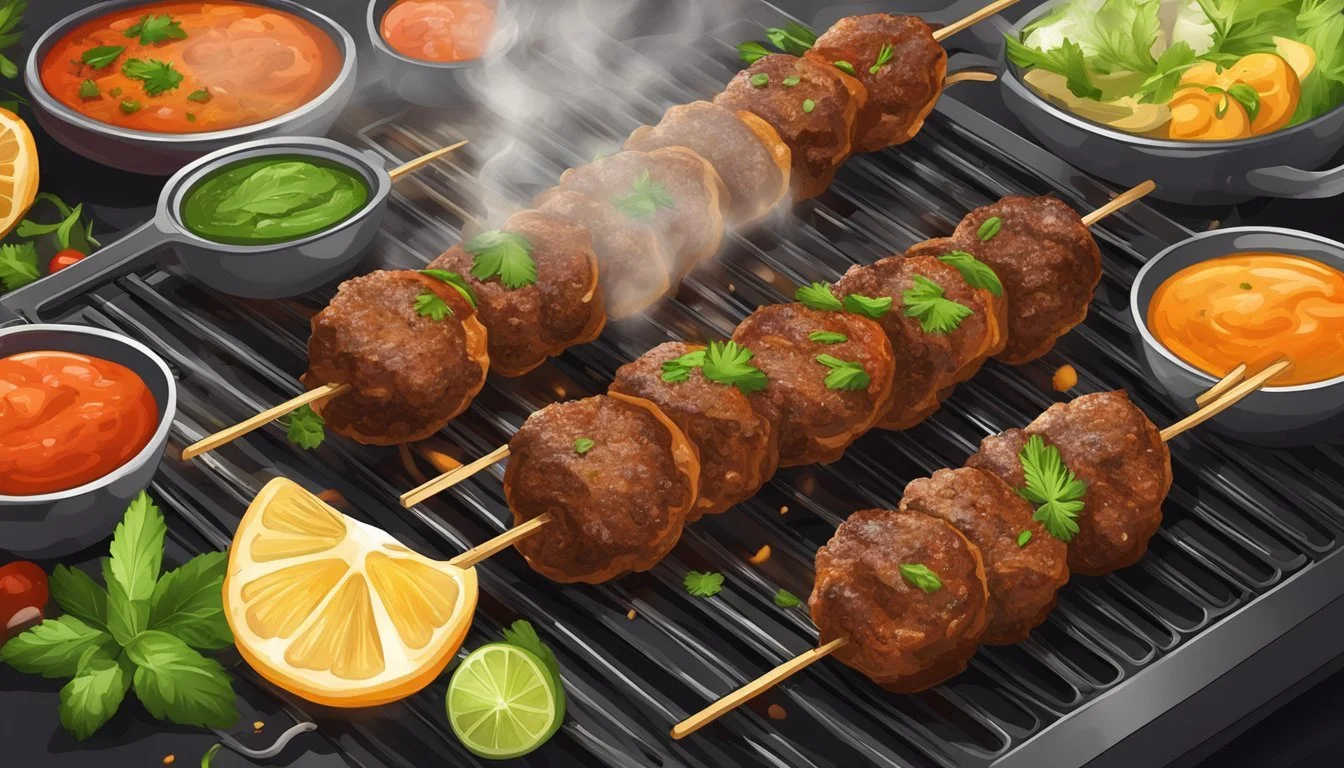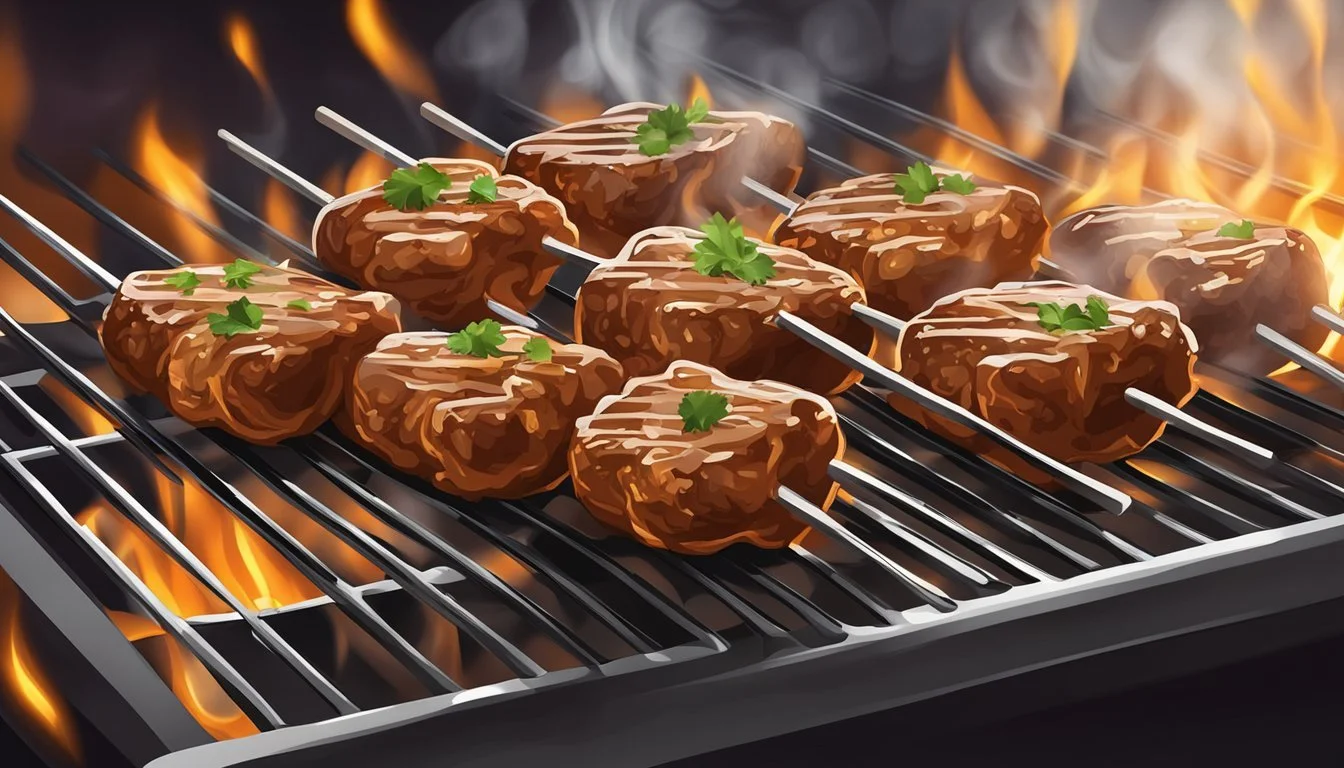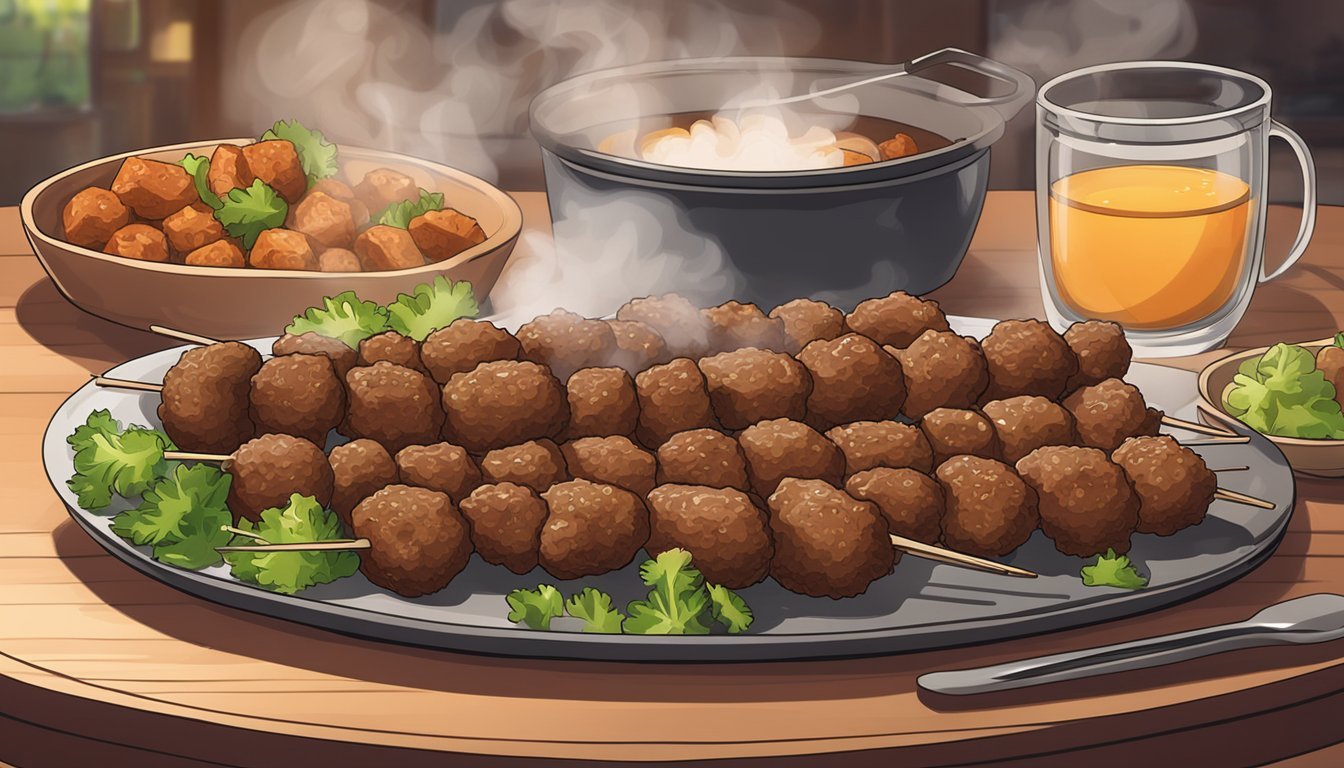Best Way to Reheat Kofta Kebab
Ensuring a Juicy and Tender Experience
Kofta kebab, a favorite in Middle Eastern cuisine, is typically made from ground meat with savory spices, and it’s loved for its tenderness and flavor. Preserving that tenderness and juiciness during reheating is important, as it ensures that the reinvented meal is as enjoyable as when it was first served. The best ways to reheat kofta kebabs focus on retaining moisture and evenly warming the meat without drying it out.
Several effective methods can be employed to heat kofta kebabs, each having its own merits. Utilizing the oven offers a gentle reheating process, which is key to maintaining the kebabs’ moistness. When using a skillet or a pan, the cook can control the heat level and use steam to prevent the meat from becoming dry. In contrast, microwaving, though faster, requires careful attention to avoid overcooking. The method chosen will depend on the resources available and the time one has to prepare the dish for serving.
Understanding the principles behind these reheating methods empowers individuals to enjoy deliciously warm kofta kebabs that remain juicy and tender, capturing the essence of the meal's original preparation. This reapplies the flavors and textures intended in the initial cooking process, allowing for a dining experience that is as close to the original as possible.
Understanding Kofta Kebab
Kofta kebab is a staple Middle Eastern dish that blends minced meats with a variety of seasonings to create a rich, flavorful experience. This section explores the fundamental components of the dish and its varied cultural significance.
Ingredients and Variations
Kofta kebabs are traditionally made from ground meats such as lamb, beef, ground beef, or chicken, mixed with finely chopped onions, parsley, and garlic. Seasoning is central to its taste, typically involving salt, black pepper, and a range of Middle Eastern spices like cumin, paprika, coriander, cardamom, cinnamon, nutmeg, and sometimes sumac. The ingredients and spices may vary, reflecting regional preferences and recipes. For instance, a Persian kofta might include a hint of sumac for acidity, while a Mediterranean variation may incorporate more garlic and parsley.
Meat Base: Typically lamb, beef, ground beef, or chicken
Aromatics: Onions, garlic, and parsley
Spices: A blend that may include cumin, black pepper, paprika, coriander, cardamom, cinnamon, and nutmeg
Kofta Kebab Across Cultures
While kofta kebab is recognized as a Middle Eastern dish, its popularity spans across various cultures, with each putting a unique twist on the classic. In Middle Eastern recipes, spices play a crucial role, often being toasted to intensify their flavors before blending with the meat. Mediterranean versions might feature lighter seasonings and make use of lamb or chicken in particular. Across all variations, though, the key to a delectable kofta kebab stays the same: a harmonious balance of meat, aromatics, and a carefully chosen spice blend that yields a tender and juicy dish.
Preparation Techniques
The success of a juicy and tender kofta kebab lies in the proper mixing and shaping of the meat, as well as the cooking technique used. Whether grilling or baking, careful attention to detail can make all the difference.
Mixing and Shaping
To create flavorful kofta meatballs, one should combine ground meat with finely minced onions, fresh parsley, and a blend of herbs and spices. It's important to mix the ingredients thoroughly to ensure that the flavors are evenly distributed throughout the meat. Once mixed, shaping the meat around skewers or forming it into meatballs should be done with a light touch to keep the mixture from becoming too dense.
Start with a base of ground meat, commonly beef or lamb, with a good fat content for both flavor and moisture.
Additions:
Finely chopped onions
Fresh parsley and herbs for a burst of freshness
Spices such as cumin, sumac, and coriander
Tips for shaping:
Wet your hands before shaping to prevent sticking.
Form meat around wooden skewers or into meatballs, ensuring they are not too tight or heavy.
Grilling Methods
Grilling kofta kebab imparts a delightful char and smoky flavor that can't be replicated otherwise. One has to preheat the grill to the appropriate temperature before placing the kofta on the grates. Grilling should be done over medium heat to allow the kofta to cook through without burning on the outside.
Preheat the grill to a steady medium temperature, around 350 to 375 degrees Fahrenheit.
If using wooden skewers, soak them in water beforehand to prevent burning.
When grilling, turn the kofta occasionally for even cooking and a nice external char.
Baking Alternatives
Baking is a viable alternative for those who prefer not to grill. To bake kofta kebabs, one should preheat the oven to a high temperature, around 350 to 400 degrees Fahrenheit, and place the meat on a baking sheet in the middle of the oven to ensure even cooking without drying the meat out.
Preheat the oven to between 350 and 400 degrees Fahrenheit — a higher temperature ensures the outside becomes nicely browned while the inside stays moist.
Arrange the kofta on a baking sheet, leaving space between each one to allow air to circulate and ensure even cooking.
Storing Kofta Kebab
Proper storage of kofta kebab is crucial for maintaining its freshness and flavor, whether one plans to enjoy it within a few days or save it for future meals. Kofta kebab can be kept tasty and safe by following simple, specific methods for refrigeration and freezing.
Refrigeration
For short-term storage, kofta kebab should be placed in an airtight container and refrigerated. To maximize its shelf life in the fridge while ensuring its savory qualities, cool the kebabs down to room temperature before transferring them into storage. The kebabs can be stored like this for 3 to 4 days. If an individual prefers to prepare the lamb or beef mixture in advance, they can form it onto skewers and then refrigerate the skewer-covered platter, tightly wrapped in aluminum foil or plastic wrap, for 1 to 2 days before cooking.
Freezing for Longevity
For those who wish to extend the life of their kofta kebab, freezing is an excellent option. Ensure the kebabs are cooled completely before transferring them to freezer-safe airtight containers or freezer bags. Kofta kebab can be effectively frozen for several months, retaining its quality. To use, simply thaw in the refrigerator overnight before reheating. This make-ahead strategy is not only a timesaver but also a way to have delicious kofta kebab readily available.
Best Reheating Practices
Preserving the juiciness and tenderness of kofta kebab during reheating is crucial. Using the right method and temperature can ensure that the kebabs remain flavorful and moist.
Using Your Oven
In a preheated oven set to 350°F (about 180°C), one can effectively reheat kofta kebabs by placing them on a baking sheet. Covering the kebabs with aluminum foil can trap the steam, keeping them juicy and tender. Reheat the kebabs until they reach the desired temperature, typically for about 10 to 15 minutes.
Skillet Reheating
On the stovetop, heat a skillet with a small amount of cooking oil over medium heat. Add the kebabs and turn them frequently for even heating. To prevent dryness, one can use a lid to create a moist environment, enhancing the juiciness of the kebabs. This should take about 5 to 7 minutes.
Microwave Technique
Using a microwave, place kofta kebabs in a microwave-safe dish, add a splash of water to avoid drying out, and cover. Heat on medium power in one-minute bursts until they reach the required temperature, ensuring the kebabs are heated through but still maintain their tenderness.
Air Frying Method
An air fryer can reheat kofta kebabs efficiently. Preheat the air fryer to 350°F (about 180°C) and place the kebabs in the basket. Heat for 3-4 minutes, turning halfway through. This method gives a slightly crisp exterior while keeping the inside moist.
Reheating on the Grill
Preheating a grill pan over medium heat mimics the original cooking method. Place the kebabs on the grill and turn them occasionally. This infuses a smoky flavor and maintains their juiciness for about 5 to 6 minutes.
Avoiding Dryness and Maintaining Juiciness
Regardless of the method, maintaining a moderate temperature and monitoring closely are key to avoiding overcooking. Adding a bit of water or covering with foil can help maintain moisture. One may also baste the kebabs with a marinade or sauce to enhance flavor and tenderness.
Serving and Accompaniments
The pleasure of enjoying kofta kebabs is amplified when they are paired with the right breads, sauces, and sides. Each accompaniment should complement the flavors of the kofta to ensure a balanced and fulfilling dining experience.
Breads and Wraps
Kofta kebabs are traditionally served with pita bread, providing a soft and pliable wrap that soaks up the juices and flavors of the meat. The breads act as a vessel for the kebabs and additional garnishes. Alternatively, one might opt for other varieties of flatbreads that offer a slight crispiness to contrast the tenderness of the meat.
Sauces and Dips
A range of sauces and dips contribute to the overall taste profile of kofta kebabs. A creamy tzatziki sauce made with shredded cucumbers, Greek yogurt, and fresh herbs provides a cool and refreshing complement. Tahini sauce, a rich, nutty condiment made from tahini and olive oil, adds a robust flavor. For a spicier kick, one might include a harissa or a chili-based sauce.
Pairing with Sides
Kofta kebabs are often accompanied by a variety of side dishes to complete the meal. A Greek salad bursting with fresh vegetables, tangy feta, and a light dressing can serve as a vibrant contrast to the savory meat. Rice or couscous (What wine goes well with couscous?), lightly seasoned with herbs and olive oil, make for wholesome sides that absorb the kofta juices. The inclusion of a fattoush salad, with its mix of fresh vegetables and pieces of toasted or fried bread, adds a satisfying crunch.
Nutritional Profile
When examining the nutritional content of kofta kebab, it is important to consider the macronutrients provided by its primary ingredients, such as the protein content from meats and the health benefits of herbs and spices used in its preparation.
Protein and Macros
Protein serves as a building block for muscles, skin, and enzymes and is an essential component of a healthy diet. Kofta kebab can be made from various types of ground meat, each contributing its distinct macronutrient profile.
Ground Lamb: A rich source of protein and provides essential amino acids. It also contains fats, which should be considered in the context of a balanced diet.
Ground Beef: Similar to lamb, ground beef is high in protein and contains vitamins B12 and B6, essential for brain health and energy production.
Ground Chicken and Ground Turkey: These are leaner protein options and are particularly lower in saturated fat compared to lamb and beef.
Each serving size of kofta kebab (assuming approximately 100 grams of meat) generally provides:
Lamb: 25 grams of protein
Beef: 26 grams of protein
Chicken: 23 grams of protein
Turkey: 24 grams of protein
Herbs and Spices Benefits
Herbs and spices not only add flavor without the need for excessive salt but also offer several health benefits:
Herbs like parsley and mint: Provide micronutrients and have anti-inflammatory properties.
Spices such as cumin and paprika: Contain antioxidants and may aid in digestion.
In addition to their micronutrient content, herbs and spices used in kofta kebab are believed to have positive impacts on overall health due to their medicinal properties recognized in various cultures.
FAQs and Tips
In this section, one will find pertinent information regarding how to maintain the succulence and taste of reheated kofta kebabs. The aim is to answer common concerns while providing practical advice to keep those flavors locked in.
Common Questions
What's the best way to reheat kofta kebabs to keep them juicy?
To retain the juiciness, one should gently reheat the kofta kebabs in an oven preheated to 350°F (about 180°C), optionally wrapped in aluminum foil to trap steam and moisture.
How can one ensure the kebabs remain flavorful after reheating?
Season them lightly with spices, onions, or garlic before reheating to enhance their flavor. For best results, one might use a skillet on medium heat, adding a touch of oil if necessary, and reheat for 30 seconds before stirring and continuing for another 30 seconds.
Is it possible to reheat kofta kebabs quickly and if so, how?
Yes, microwaving on medium power with a splash of water and covering the dish with plastic wrap can be a quick method, taking about three minutes with additional one-minute intervals until the desired temperature is reached.
Is it safe to add sugar or other sweeteners when reheating to improve the taste?
One can add a very small amount of sugar or sweeteners to enhance the caramelization and flavor, but one should be cautious not to overdo it as it may alter the authentic taste of the kofta.





